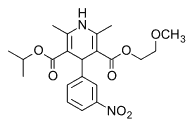Nimodipine
Nimodipine (marketed by Bayer as Nimotop®) is a dihydropyridine calcium channel blocker originally developed for the treatment of high blood pressure. It is not frequently used for this indication, but has shown good results in preventing a major complication of subarachnoid hemorrhage (a form of cerebral hemorrhage) termed vasospasm; this is now the main use of nimodipine. more...
Dosage
The regular dosage is 60 mg tablets four times daily. If the patient is unable to take tablets orally, it is given via intravenous infusion at a rate of 0.5-1 mg/hour (lower dosage if the body weight is <70 kg or blood pressure is too low).
Usage
Because it has some selectivity for cerebral vasculature, nimodipine's main use is in the prevention of cerebral vasospasm and resultant ischemia, a complication of subarachnoid hemorrhage (a form of cerebral bleed). Its administration begins within 4 days of a subarachnoid hemorrhage and is continued for three weeks. If blood pressure drops by over 5%, dosage is adjusted. There is still controversy regarding the use of intravenous nimodipine on a routine basis (Allen et al 1983, Janjua & Mayer 2003).
A 2003 trial (Belfort et al) found nimodipine was inferior to magnesium sulfate in preventing seizures in women with severe preeclampsia.
Mode of action
Nimodipine binds specifically to L-type voltage-gated calcium channels. There are numerous theories about its mechanism in preventing vasospasm, but none are conclusive.
Contraindications & side-effects
Nimodipine is associated with low blood pressure, flushing and sweating, edema, nausea and other gastrointestinal problems. It is contraindicated in unstable angina or an episode of myocardial infarction more recent than one month.
Read more at Wikipedia.org



